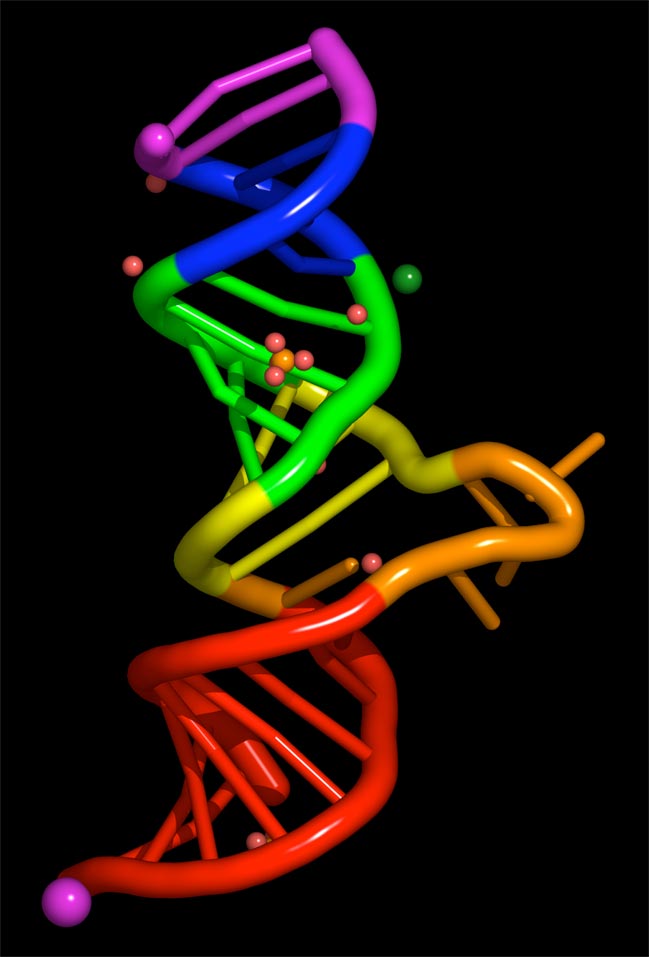Chemical Evolution: The RNA World (Part I)
By The Late Dr. T.D. Singh | Июл 25, 2009

Genetic information flows from DNA, in the nucleus of each cell, to RNA, which carries the information out of the nucleus into the body of the cell and uses the instructions encoded in it to produce proteins (which act as enzymes and also provide the structural framework of cells). However, the duplication of DNA requires numerous enzymes that catalyze those reactions. And enzymes are proteins themselves – the end product of the information coded in DNA. In other words, proteins are required for DNA synthesis and DNA is required for protein synthesis.
How then could the
first living cell with DNA-based molecular biology
have originated by spontaneous chemical processes
on the pre-biotic earth? This
has been the chicken and
egg problem of life’s evolution from chemicals – Which
came first, DNA or the protein molecule?
In the late 1960s, several
biologists – including Francis Crick, Carl Woese and
Leslie Orgel – suggested
that the ancestor molecule
was neither DNA nor protein, but RNA. RNA, they
suggested, might have catalyzed reactions necessary for
replication as well as provided the genetic information necessary to replicate
itself. Self-replicating RNA-based systems would have
arisen first, and DNA and
proteins would have been
added later. DNA could
have evolved from RNA
and, then, being more stable,
taken over RNA’s role as the
guardian of heredity.
This idea further got support in the early 1980s from
the independent discoveries
of Thomas Cech and Sidney
Altman of a kind of RNA
that catalyzes a reaction.
These catalytic RNA molecules have subsequently
been termed as “ribozymes.”
In 1986, Walter Gilbert, in an
article in Nature, portrayed
the primordial world as
“RNA World” where RNA
molecules catalyze their
own synthesis. Since then,
the term “RNA World” has
stuck to the general hypothesis – RNA first, DNA and
protein later.
Researchers continue to discover new func-
tions for existing RNA, illustrating repeatedly how versatile these molecules can be.
The recent determination of
the structure of the ribosome,
showing that it is a ribozyme,
gave further support to the
belief in the RNA World.
However, there are many difficulties and problems in the
RNA World.
Leslie Orgel,
one of the scientists who first
proposed it in the 1960s, himself concedes that researchers who have attempted to
illustrate the possibility of
spontaneous generation of
the chemical elements of RNA
itself have had only modest
success. Ribose, the sugar that
is part of the backbone of the
RNA molecule, is difficult to
create from hypothetical early
earth conditions, except in
very small quantities. Stanley
Miller and his colleagues have
also recently reported “ribose
and other sugars have surprisingly short half-lives for
decomposition at neutral pH,
making it very unlikely that
sugars were available as pre-biotic reagents.”
RNA World assumes that in
the primordial world, ribonucleotides spontaneously
condense into polymers to
form RNA molecules and
RNA molecules, once formed,
would have the catalytic
activity to replicate itself,
and a population of such
self-replicating molecules
would arise. However, it is
objected that even if RNA
could have formed spontaneously, it would have been
continuously degraded by
spontaneous hydrolysis and
other destructive processes
operating on the primitive
Earth.
Joyce and Orgel point
out many detailed problems
with these postulates of
RNA World.
They finally suggest not to
accept “the myth of a self-replicating RNA molecule
that arose de novo from a
soup of random polynucleotides. Not only is such a
notion unrealistic in light
of our current understanding of pre-biotic chemistry,
but it should strain the credulity of even an optimist’s
view of RNA’s catalytic
potential.”
Similarly, Crick
has expressed great doubt
about the RNA World. He
says, “At present, the gap
from the primal ‘soup’ to the
first RNA system capable of
natural selection looks for-
biddingly wide.”
This article is an excerpt from
the late Dr. T.D. Singh’s book Life,
Matter and Their Interactions.















